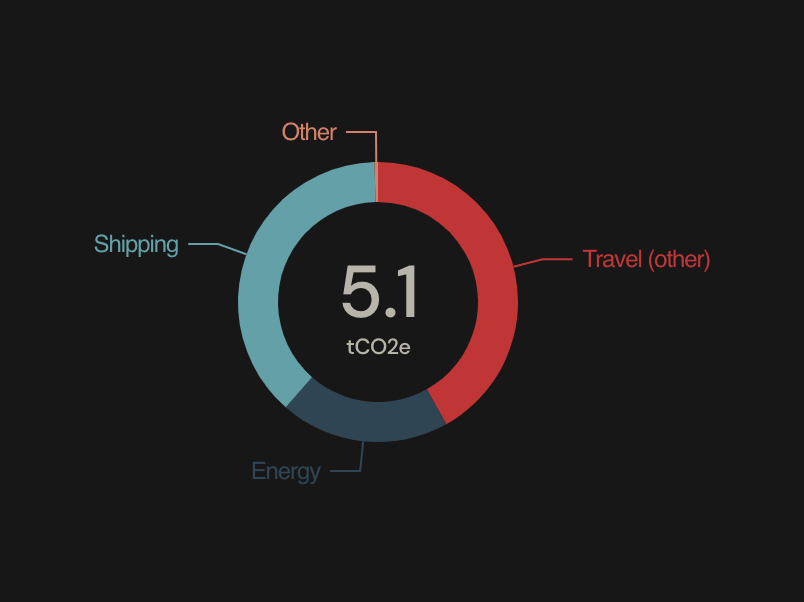Environmental Responsibility Statement
The awareness of climate change came onto my radar through my campaigning work with Greenpeace. Our climate reality seeped into my lifestyle gradually, then my emotions inseparably over the past 10 years. Understanding my response-ability, in this human-caused (although not by all humans) existential crisis, I did a lot of pausing and reevaluating choices. Activism led me to burnout, self-healing led me to art.
Art can mend a broken story.
Products of imagination influence the way humans perceive and interact with reality. Art and entertainment sectors have a huge role to play in reframing stories and offering healing narratives. But it is important to address how artistic products are made and consumed. The art world has to lead by example. Aspirational words and futuristic optimism are useless if in their making they damage our environment in the present time.
Why is it important for me to release a carbon impact report?
Releasing an environmental impact report for my practice/business/life is a solid, quantifiable step toward visualizing where I stand in the grand scheme of things. Eventually, terminologies around anthropogenic CO2 emissions will become less encrypted, ESG data more accessible, calculators automated, and reports regulated. This will become a standard practice for all types of entities.
I am a tiny operation, a small artist, living and working in a 2bdr house with 5 individuals including our family dog. My carbon footprint likely adds up to be very small in comparison to big-name artists. But I would very much like to know where I stand among small operations like mine, and how big operations measure against us. The challenge for me is to keep my carbon footprint low regardless of a growing audience or success in the traditional sense. A carbon report is a way to keep me accountable. Make my environmental impact part of the business decision-making process from the get-go.
How I calculated my carbon footprint.
My 2022 Carbon Impact. The detailed report can be found here.
I used Gallery Climate Coalition’s carbon calculator. It’s fairly easy to populate with accessible information. It takes into account big-impact items such as travel, energy consumption, and shipping.
Overestimating my carbon footprint instead of underestimating felt more reasonable to me. I haven’t flown anywhere last year and I didn’t ship artwork. So I included most aspects of my personal life and household carbon footprint in the overall calculation.
I included personal deliveries made to my home (whether it’s for baby diapers or misc amazon shopping items) on average 3 times per week and 3 boxes per each delivery. Again, this is overestimating. I usually bundle shipments into monthly subscriptions. I accounted for the local warehouse trips which are about 12 miles distance from my home. 3 deliveries per week equate to 156 trips per year. I also accounted for international air and sea freights, guessing that most goods I order from Amazon, or at least their raw materials ship from China. About 25 kg of miscellaneous goods per month. Lastly, I added other types of deliveries such as food orders.
Commitments in my practice.
Setting targets for the future may be important for planning, especially for larger organizations that need to drastically reduce their impact. As a small operation, I would like to list some of the steps that I have already been taking to keep my carbon footprint minimal:
Continuing to compost all possible organic waste through the City of Los Angeles organic waste program, or via backyard composting since 2017.
Integrating gardening and composting as a somatic extension of my art/life practice.
Committing to replacing single-use plastics, disposable art tools, and hazardous inks, with clean, reusable, upcycled materials in the production and shipping of artworks.
Committing to keeping international travel, less than 5 times/year.
Impact I could not calculate.
Carbon calculators don’t take into account all the nitty gritty activities that come to mind. I’m left questioning, what is the carbon footprint of everything?
What is the carbon footprint of my internet use? How about the software that I use? What is their use of energy? For example, what is the carbon footprint of viewing an Instagram post? What is the carbon footprint of prompting A.I. to play “Five Little Monkeys”?
What are the carbon footprints of my two children and my one dog? I am acutely aware that I live in the United States where conveniences are intricately built into my life. In comparison to MAPA (Most Affected People and Areas), I am a consumer, a polluter. Should artists, organizations, and communities be accountable only for their business practice, or by extension, their personal lives?
This is hard.
Questioning every aspect of work and life, measuring every step against its carbon print doesn’t seem feasible. But I believe it is an artful, imaginative, brave, and meaningful thing to do at this point in human history.
